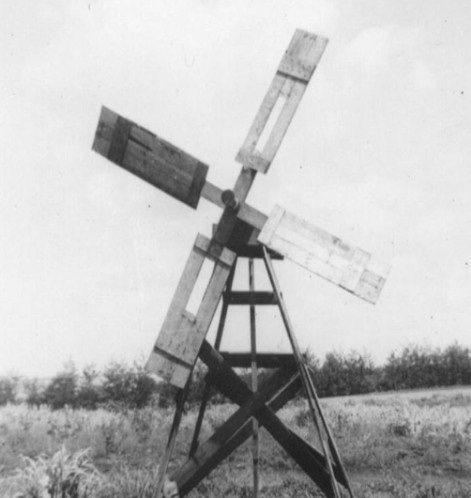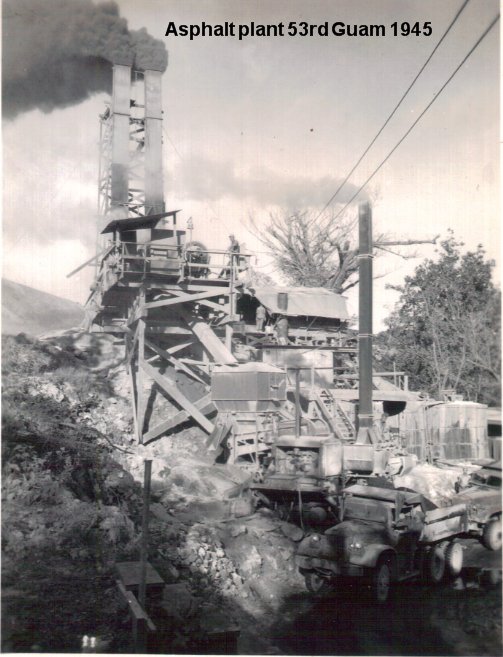World War II Photos

Adm. Ben Moreell Photo The 53rd “A Great outfit!”
The famous New York Daily News cartoonist and former WW2 Marine Bill Gallo made this drawing for a WW2 Seabee friend. They first met in a cave on Saipan.
 4-20-43 Recruiting Booklet (click cover)
4-20-43 Recruiting Booklet (click cover)















The Seabees built the airstrip for the “Black Sheep”

|
Guam, invaded in July, '44, meant the retaking of an American possession lost to the Japs in the early part of the war. There was a lot of sentiment in this fight for Guam. Every man was out to do his best. Causeways were launched but could only go into the reef where supplies were loaded onto vehicles and taken ashore over the coral reef. Barges were kept busy going from ship to reef where LVT's took up the load and carried it onto the beach. From their many hidden gun batteries, the Japs made many attempts to drive off the supply line but the troops ashore finally knocked these positions out. Contributed by John Ratomski |

UDT
- 3 "SEABEE
DEMOLITION TEAM" Welcoming in the Marines at Guam.
Look at the date on the sign.
7-14-44. The invasion of Guam started on
7-21-44 ! They were there seven days before the invasion.



53rd Seabees bridge construction.


The 53rd Leaving Guadalcanal for the Bougainville campaign.
 Inside the LST
looking at two D6's with angle blades pushing beach to the LST.
One International TD-18 of WWII era will out work a
motor grader on beach landings. The time it takes to move the same cubic yards
will be the same. The dozer pushes more yardage (even though the dozer has a
slower travel time) and the TD-18 will use 1/2 the amount of diesel fuel the
motor grader uses. Cost wise: TD-18, sand eats up steel tracks but 1/2
fuel cost, will spin in the sand, no jerk to the final drives. Motor
Grader, high fuel cost! Over double the trips to move the same yardage. It spins
in the sand and wheel hops!! Big time jerk on the final drives! Very destructive
on the machine! $$$ The way people think changes, the earth don't.
Mike Baldwin
Inside the LST
looking at two D6's with angle blades pushing beach to the LST.
One International TD-18 of WWII era will out work a
motor grader on beach landings. The time it takes to move the same cubic yards
will be the same. The dozer pushes more yardage (even though the dozer has a
slower travel time) and the TD-18 will use 1/2 the amount of diesel fuel the
motor grader uses. Cost wise: TD-18, sand eats up steel tracks but 1/2
fuel cost, will spin in the sand, no jerk to the final drives. Motor
Grader, high fuel cost! Over double the trips to move the same yardage. It spins
in the sand and wheel hops!! Big time jerk on the final drives! Very destructive
on the machine! $$$ The way people think changes, the earth don't.
Mike Baldwin

The 53rd on Bougainville!


53rd on Bougainville.


How the airstrip was cleared on Bougainville. They put two International TD-18 bulldozers side by side and cleared the airstrip from the center of the width to the outside. This was done for the length of the airstrip. When the clearing got real tough, they'd put another TD-18 behind, pushing the front one. At times there would be two in front and two in back pushing. (I'd like to find a picture of that) This picture is of two International TD-18 crawler-tractors with Bucyrus-Erie bulldozers, working side by side on the fighter strip on Bougainville. It is from the 77th history book.

The crawler-tractor on the left is an Allis-Chalmers HD-7 pulling sheepfoot rollers. The crawler-tractor on the right is an International TD-18 pulling a carryall. From left to right bottom photo: the first three crawler-tractors are International TD-18's. Then there's three Caterpillar D-8's. A International TD-18, the last one is a Caterpillar D-8. All Carryalls are LeTourneau model "LS".This is grading on the fighter strip on Bougainville. It is from the 77th history book. It states in the 77th history book that the 53rd furnished most of the equipment for the job. Looks like the 77th built most of the buildings for MAG 24 (Marine Aviation Group).

Top picture is of an Allis-Chalmers HD-14 (the reinforcement strip welded to the track frame determines the fact) pulling a LeTourneau model "LS" carryall.

The top picture is of a 3-wheeled roller compacting the fighter strip for finished grade. Bottom picture shows the finished fighter strip before pierced planking was placed.



Where there are Seabees there is BEER.


This picture shows what down to earth homespun Seabees did in the 1940's, and it still works today. The middle picture shows two Seabees with an island made replacement engine oil cooler on a Caterpillar D-8. These Seabees added a radiator from a truck for the replacement engine oil cooler. The air moving through the engine oil cooler was forced by the engine fan. Classic Seabee !!!!!


A main-stay bulldozer during the early WWII days.

Mater of fact, International built these TD-18's from 1939 to 1958. That says a lot!

LeTourneau started production on the LS and LP in 1940. They were the first carryalls to have the "radius" A-arch. This was a vast improvement over the A-frame carryalls (the A-frame would break; the A-arch would twist with radial-torsion and not break). The LS was paired with Cat D7's (the Seabees had very few of these, I've been told if you saw a Seabee a D7, you knew it was stolen from the Army) International TD-18 and Allis-Chalmers HD-14 and HD-10 and the Cat D8. The LP was paired mainly with the Cat D8 or sometimes the Allis-Chalmers HD-14. By the way, the tractor carryall combination on the front of the WWII Allis-Chalmers Service Manual is: HD-14 pulling a GarWood carryall. The carryall was built by the world famous speed-boat racer Garfield Wood! Check him out on the internet!


WWII Allis-Chalmers ad shows eight HD-14 crawler-tractors pulling GarWood carryalls. There is also two HD-14 pusher tractors. That's one pusher tractor to four tractor-carryalls.

Working on Marine Drive Bougainville.

Marine Drive.

Jap Bombers scored a direct hit on Gas & oil dump on
Bougainville.
8,000 drums were set on fire. Marines & Seabees battled the flames for 30 hours
before getting it under control.

Bottom picture is a Allis-Chalmers HD-14 loading a LeTourneau "LS" carryall on a LST.

Jack and Brown (first cousins)

Reed, Baldwin, Hott, Brown, Dix

On Bikini Jack Baldwin on right, "Moose the Diver" next to him, then Simms




Coming home Hott, Baldwin, Reed, Brown







